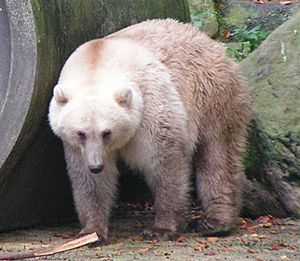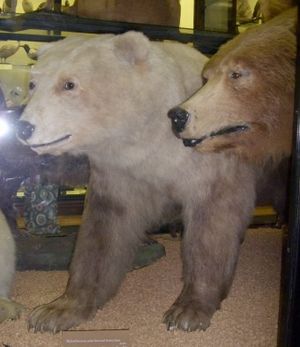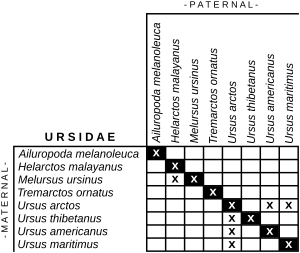Grizzly–polar bear hybrid facts for kids
Quick facts for kids Grizzly–polar bear hybrid |
|
|---|---|
 |
|
| Polar/brown bear hybrid at Osnabrück Zoo | |
| Scientific classification |
|
| Kingdom: | Animalia |
| Phylum: | Chordata |
| Class: | Mammalia |
| Order: | Carnivora |
| Family: | Ursidae |
| Tribe: | Ursini |
| Genus: | Ursus |
| Species: | |
A grizzly–polar bear hybrid is a rare animal that is a mix of a polar bear and a grizzly bear. People also call them grolar bears or pizzly bears. These special bears have been seen both in zoos and in the wild.
In 2006, scientists officially confirmed that these hybrids exist in nature. They did this by testing the DNA of a bear found near Sachs Harbour, Northwest Territories, in the Canadian Arctic. This bear looked very unique. Since then, eight more of these hybrid bears have been confirmed. All of them came from the same female polar bear.
Before 2006, people had reported seeing bears that looked like a mix of polar and grizzly bears. However, there were no DNA tests available back then to prove their family tree. Scientists have also found that polar bear DNA has mixed with brown bear DNA over a long time. This happened during the Pleistocene period.
Contents
Wild Discoveries: How Hybrids Appear
Scientists now have several suspected sightings and eight confirmed cases of these hybrid bears. This means that ideas about how these mixed bears might appear in nature are becoming more real. Polar bears and grizzly bears are like "sister species." They often live in areas next to each other. But they usually don't meet much. Polar bears hunt, breed, and even have their babies on sea ice. Grizzly bears, however, mostly live on land.
First Discovery in 2006
On April 16, 2006, a hunter named Jim Martell from Idaho shot a bear. He was hunting near Sachs Harbour on Banks Island, Northwest Territories. Martell thought he was hunting a regular polar bear. But officials became interested in the animal.
The bear had thick, creamy white fur like a polar bear. But it also had long claws and a humped back. Its face was shallow, and it had brown patches around its eyes, nose, back, and feet. These are all features of a grizzly bear.
A DNA test was done in British Columbia. It confirmed that the bear was a hybrid. Its mother was a polar bear, and its father was a grizzly bear. This was the first time this hybrid was officially found in the wild. We already knew that these two types of bears could have babies together. Other bear hybrids had been born in zoos before.
More Hybrid Bear Sightings
On April 8, 2010, another hunter named David Kuptana shot a bear. He was from Ulukhaktok on Victoria Island. He also thought he had shot a polar bear. But after checking the bear and testing its DNA, they found something amazing. This bear's mother was a grizzly-polar hybrid, and its father was a grizzly bear.
This bear had features that were in between grizzlies and polar bears. For example, it had brown fur on its paws and long claws. Its head looked more like a grizzly's head. Between 2012 and 2014, six more hybrid bears were found. Some were killed by hunters, and others were caught by scientists.
Why Brown Bears Are Moving North
In 1951, a grizzly bear was killed on Banks Island. But until recently, it was rare for grizzly bears to go far north of Canada's mainland coast. In 1991, one or more grizzly bears were seen hunting seals. They were also seen hunting polar bears on the sea ice near Melville Island. This was more than 500 kilometers from the mainland coast.
In 2003 and 2004, a team of geologists found proof of a grizzly bear in that area. They had photos and DNA evidence. Their report also gathered information about other sightings in the Canadian Arctic Archipelago.
Grizzly bears also seem to be moving east. They are crossing the Barren Grounds towards Hudson Bay. They are also moving south towards northern Saskatchewan and Manitoba. From 2003 to 2008, seven grizzly bears were seen in Wapusk National Park. This park is south of Churchill, Manitoba. Polar bears use this area to have their babies and as a safe place when the bay is not frozen.
Naming These Unique Bears
After the 2006 discovery, the media gave these hybrid animals many different names. Some popular names are pizzly bear, grolar bear, and polizzly. But there isn't one official name that everyone agrees on.
Canadian wildlife officials have suggested calling the hybrid "nanulak." This name comes from the Inuit words for polar bear (nanuk) and grizzly bear (aklak).
Sometimes, the name of the father's species comes first in these mixed names. So, if a male polar bear and a female grizzly had a baby, it might be called a nanulak or a "pizzly bear." If a male grizzly and a female polar bear had a baby, it might be called a "grolar bear" or an aknuk.
Characteristics: What They Look Like and How They Act
Two grizzly–polar hybrid cubs were born at Osnabrück Zoo in Osnabrück in 2004. One was female and one was male. Their physical features are generally in between those of a polar bear and a grizzly bear.
For example, their bodies are smaller than polar bears but bigger than grizzlies. Their heads are also in between: not as broad as a grizzly's, but not as lean as a polar bear's. They have long necks like polar bears. But they have small shoulder humps like grizzlies. The bottom of their feet are partly covered in hair. Polar bears have feet fully covered in hair for insulation. Grizzly bears have hairless soles.
The hair of the hybrids also shows a mix of traits. Polar bear hair is hollow inside. Grizzly bear hair is usually solid or has small hollow parts. In the male hybrid, the paw hair was solid. But the dark back hair was somewhat hollow, though less so than polar bear hair. The female hybrid's hair had different amounts of hollowness.
The hybrid bears also acted more like polar bears than grizzlies. They would stomp on their toys. This is similar to how polar bears break ice. They also threw bags to the side. This is like how polar bears might throw their prey. Grizzly bears given the same bags do not do this. The hybrids were also seen lying down like polar bears. They would lie on their bellies with their back legs spread out.
Images for kids
See also
 In Spanish: Grolar para niños
In Spanish: Grolar para niños




